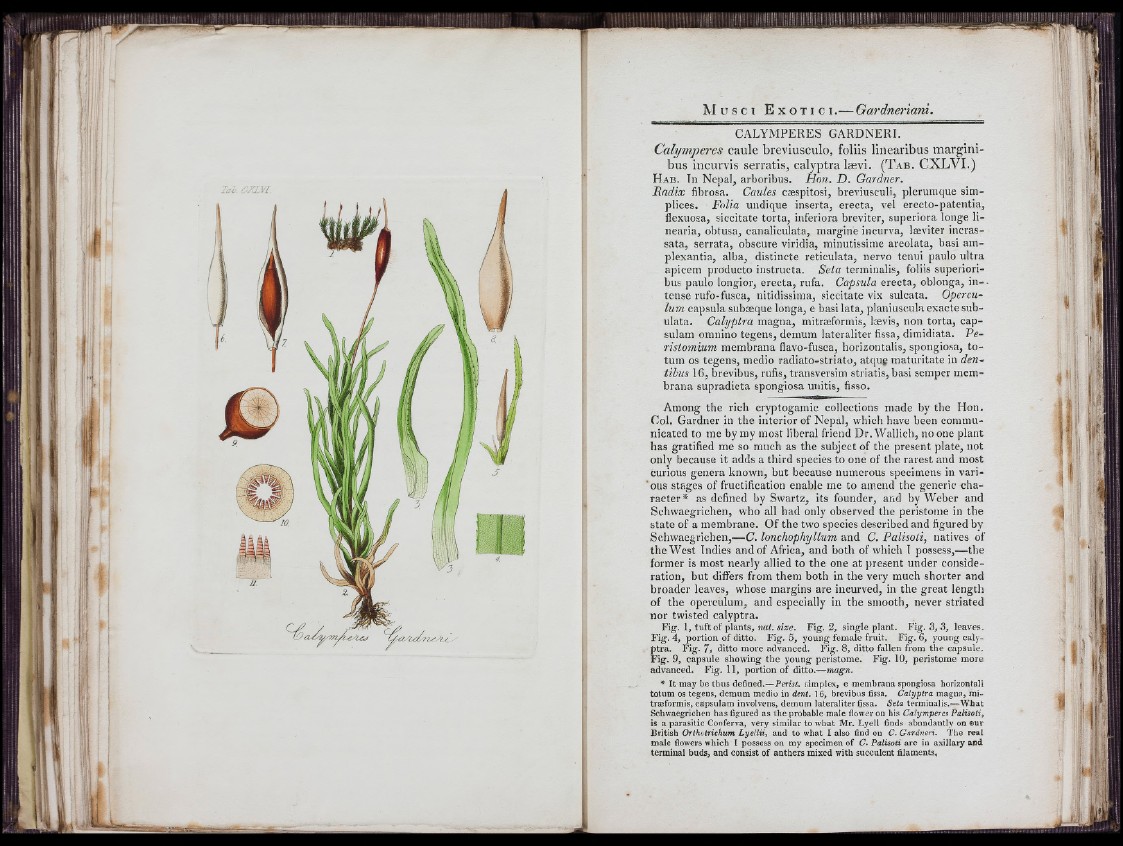
CALYMPERES GARDNERI.
Calymperes caule breviusculo, foliis linearibus margini-
bus incurvis serratis, calyptra lævi. (T a b . CXLVI.)
Hab. In Nepal, arboribus. Hon. D. Gardner.
R adix fibrosa. Caules cæspitosi, breviuseuli, plerumque simplices.
Folia undique inserta, erecta, vel erecto-patentia,
flexuosa, siccitate torta, inferiora breviter, superiora longe linearla,
obtusa, canaliculata, margine incurva, læviter incras-
sata, serrata, obscure viridia, minutissime areolata, basi am-
plexantia, alba, distincte reticulata, nervo tenui paulo ultra
apicem producto instructa. Sela terminalis, foliis superiori-
bus paulo longior, erecta, rufa. Capsula erecta, oblonga, in- ■
tense rufo-fusca, nitidissima, siccitate vix sulcata. Operculum
capsula subæque longa, e basi lata, planiuscula exacte subulata.
Calyptra magna, mitræformis, lævis, non torta, cap-
sulam omnino tegens, demum lateraliter fissa, dimidiata. Pe-
ristomium membrana flavo-fusca, horizontalis, spongiosa, to-
tuin OS tegens, medio radiato-striato, atqug maturitate in den-
tih is 1 6 , brevibus, rufis, transversim striatis, basi semper membrana
supradicta spongiosa unitis, fisso.
Among the rich cryptogamic collections made by the Hon.
Col. Gardner in the interior of Nepal, which have been communicated
to me by my most liberal friend Dr. Wallich, no one plant
has gratified me so much as the subject of the present plate, not
only because it adds a third species to one of the rarest and most
curious genera known, but because numerous specimens in various
stages of fructification enable me to amend the generic character*
as defined by Swartz, its founder, and by Weber and
Schwaegrichen, who all had only observed the peristome in the
state of a membrane. Of the two species described and figured by
Schwaegrichen,— C. lonchophyllum and C. Palisoti, natives of
the West Indies and of Africa, and both of which I possess,—the
former is most nearly allied to the one at present under consideration,
but differs from them both in the very much shorter and
broader leaves, whose margins are incurved, in the great length
of the operculum, and especially in the smooth, never striated
nor twisted calyptra.
F ig . 1, tu f t o f p la n ts , nni. «Ve. F ig . 2 , sin g le p la n t. F ig . 3 , 3 , leaves.
F ig . 4 , p o rtio n of d itto . F ig . 5 , y o u n g fem ale fru it. F ig . 6 , y o u n g c a lj-
p tr a . F ig . 7> d itto m o re advanced. F ig . 8 , d itto fallen from th e c a p su le .
F ig . 9 , c ap su le sh owin g th e y o u n g p e ristom e . F ig . 10, p e ris tom e m o re
ad v an ced . F ig . 11, p o rtio n of d itto .— magn.
* It may be thus defined.—Perist. simples, e membrana spongiosa horizontal!
totum os tegens, demum medio in dent. 16, brevibus fissa. Calyptra magna, mitræformis,
capsulam involvens, demum la teralite r fissa. Seta terminalis.-—Wh a t
Schwaegrichen has figured as the probable male flow-er on his Calymperes Palisoti,
is a parasitic Conferva, very similar to what Mr. Lyell finds abnndantly on ©nr
British Orthotrichum Lyellii, and to what I also find on C. Gardneri. The real
male flowers which I possess on my specimen of C. Palisoti are in axillary and
terminal buds, and consist of anthers mixed with succulent filaments.
! :
J i